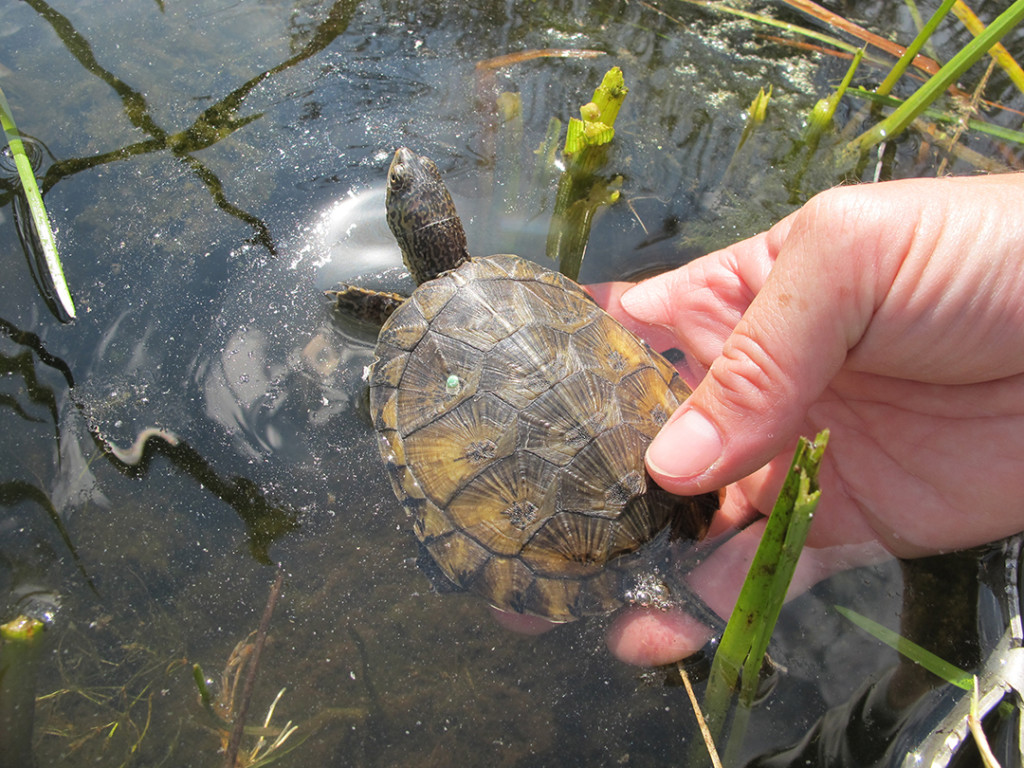By JASMINE HEALY, UW News Lab
Last Friday morning, a team of individuals from the Woodland Park Zoo and Washington Department of Fish and Wildlife met at a refuge site in Lakewood, Pierce County, to release 31 endangered juvenile western pond turtles. The 10-month- old turtles were hatched and raised at the Woodland Park Zoo as a part of the Western Pond Turtle Recovery Project established in 1991.
Twenty years ago, approximately 150 western pond turtles remained in the wild in Washington state. Predation by non-native bullfrogs as well as loss of habitat caused the only native western Washington turtle to become endangered. With the help of the recovery project, there are now between 1,200 and 1,500 turtles of this species found among six wetland sites, according to a press release by the Woodland Park Zoo.
Photo: Woodland Park Zoo and Washington Department of Fish and Wildlife released more than a hundred endangered western pond turtles today as part of a multi-institutional conservation project to restore the population. (Photo credit: Kirsten Pisto/Woodland Park Zoo)
Despite this increase in number, the turtles continue to face many challenges, according to Jennifer Pramuk, Woodland Park Zoo reptile and amphibian curator.
“One of the main threats is habitat alteration. Within the Puget Sound area, the habitat that these turtles used to live in has been converted to mini-malls, casinos and housing areas,” Pramuk said.
High school students participating in the ZooCorps Volunteer Program were among those who interacted and cared for the turtles before they were released. Intern Rhiannon Bates described feeding them and take them out of their tubs to swim and sun bathe this summer.
“It was beneficial for us to learn about the turtles and it was also nice to know that we could be a part of something that returns endangered species back to their habitats,” Bates said.
Brianna Morley was another intern who worked with the turtles for a few hours each day, Monday through Thursday. In helping to release them on Friday, she agreed that it was a bittersweet experience.“It’s sad in a way because we worked with them all summer but it was really cool to see them go off. They’re not just sitting in the zoo, they’re actually going out into the world,” Morley said.
The young turtles are grown to a minimum size of 50 grams (please convert to ounces or pounds) before they are released into the wild. At this size they can no longer fit within the mouths of bullfrogs. In the wild, it takes three years for turtles to grow to be this large; however, they are ready for release after just 10 months under conditions provided by the zoo.
Once the young turtles are released into refuge sites such as the wetland ponds found in Lakewood, they have a great chance at surviving. Upwards of 90 percent of the turtles released into these sites survive, according to the Washington Department of Fish and Wildlife. This data is found through the use of different tracking devices placed on the turtles before they are released. Of the 31 returned to the wild on Friday, approximately 20 of them had radio transmitters glued to their shells. After one year, the transmitters will be removed from the turtles.
Once the appropriate sample size was tagged with transmitters on Friday morning, the turtles were carried to one of three ponds at the Lakewood site. They were individually released as volunteers walked down a ramp and placed them in the water.
Since the turtles had never been in the wild before, the water conditions and environment were completely foreign to them, according to a Washington Department of Fish and Wildlife representative.
The Western Pond Turtle Recovery Project is one of three Pacific Northwest conservation projects currently undertaken by the zoo. As the western pond turtles slowly grow in number, the Washington Department of Wildlife and Woodland Park Zoo stress the importance of protecting water sources from contaminants and invasive species to support these turtles.
(JASMINE HEALY is a student in the University of Washington Department of Communication News Laboratory.)


